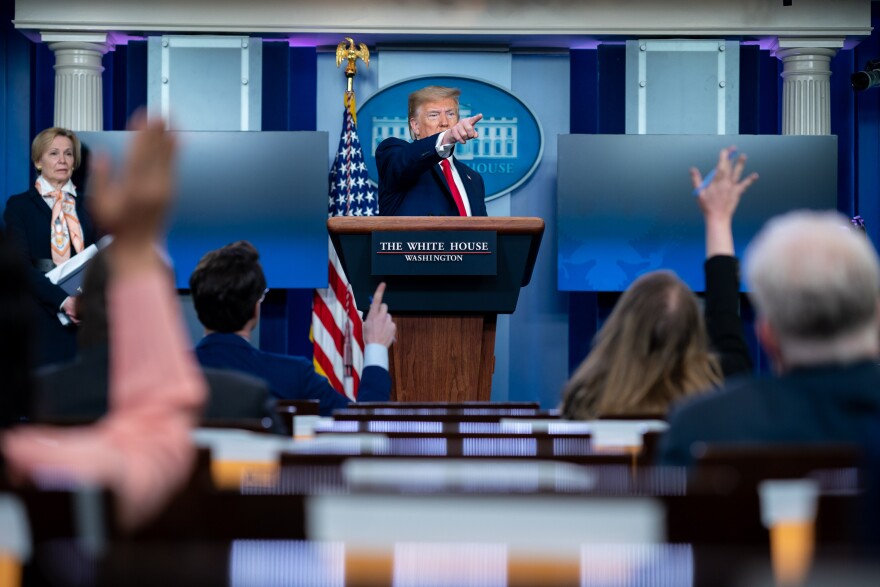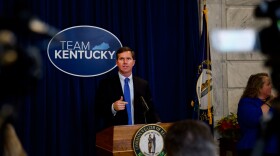White House officials, governors and mayors have all turned to scientists and their computer models to understand how the coronavirus has been racing across the country, leaving tens of thousands of people dead and waves of grief in its wake.
In this life-and-death emergency, modeling has become part of the national lexicon and "Flatten the curve," has become a household phrase.
Even President Trump, albeit belatedly and haltingly, relied on modeling to make social distancing recommendations, despite his well-known distrust of scientific expertise.
But Trump has never even reluctantly embraced modeling on climate change, despite the overall accuracy of at least 17 major warming forecasts going back 50 years. And it's unlikely that he will anytime soon, no matter how accurate the Covid-19 modeling turns out to be.
In the case of climate change, there is uncertainty inherent whenever scientists make assumptions based on incomplete data. That makes modeling an easy target for critics, including Trump, who downplay the impact of the coronavirus and deny the reality of global warming.
"The effects of Covid-19 are immediate and direct, whereas most of the effects of climate change are longer-term and indirect," said Indiana University professor David Konisky, whose research focuses on U.S. environmental and energy policy.
And attitudes toward climate change have become part of people's political identity after decades of science denialism financed by the fossil fuel industry, in a way that the pandemic's threat to public health and safety has not, he said.
"It is easier for Republican politicians to dismiss climate modeling because that is the expected way for Republicans to treat climate science," Konisky said. "This has been fostered by decades of misinformation that has emphasized the uncertainty of models, rather than their accuracy in predicting temperatures and other outcomes."
Climate And Virus Modeling Are Two Very Different Things
Modeling how a virus spreads through the population and the effects of loading the atmosphere with heat-trapping gases like carbon dioxide are very different tasks, performed under starkly different timeframes, experts said.
Regardless of the subject, coronavirus or climate change, models rely on scientists making assumptions and putting in data to produce results with varying degrees of certainty or ranges of outcomes.
Climate modeling, honed over decades, divides the Earth into grids and attempts to resolve all aspects of the climate system, from oceans to clouds to land surfaces. It uses laws and equations that help explain how the Earth's climate system functions, including physics and chemistry.
The result is a better understanding of how increasing the output of heat-trapping gases over decades raises global temperatures, for example, or changes weather patterns and alters future food supplies.
Virus modeling, in contrast, is a statistical method for making predictions about how an infectious disease — with Covid-19, a brand new one — will spread through a population.
The models, often turned to in a public health crisis, are used to forecast, among other things, how many people are likely to be infected over a period of time, and how many might die or recover, in days, weeks or months.
"The more information you have, the better," said Teresa M. Waters, a professor at the University of Kentucky College of Public Health who is on a team helping Kentucky navigate the coronavirus pandemic.
Factors like age, gender, health condition, what's known about how the virus spreads and the extent to which people are following social distancing recommendations are all part of the virus modeling equation.
What moved Trump on March 29 to extend social distancing through April was modeling presented to him by his science advisors that predicted as many as 2.2 million Americans could die, with a best-case of from 100,000 to 200,000 people.
One influential model cited by White House officials from The Institute for Health Metrics and Evaluation at the University of Washington is now projecting a far lower number, estimating that a total of 60,308 Americans could die from the coronavirus.
The numbers fell because scientists have been learning more about Covid-19, and because more people than expected have heeded the calls for physical separation, Waters said. But that model has also been called into question by some other epidemiologists for initially overestimating deaths, illustrating the variability of modeling.
Covid-19 modeling has had to be done very quickly, amid a rapidly unfolding medical crisis, with incomplete information.
"It could not be more immediate and urgent," Waters said. "There are many models and all well-intentioned. All are trying to get a handle on what we need to do to save lives and protect health."
But, she added, "You have to appreciate that these are just models. And there is a great amount of uncertainty."
Climate Models Have Accurately Forecast Arctic Warming, Seal-Level Rise
Climate modeling has been used to look back at past temperatures on Earth, and to forecast future temperatures. As computers have become more powerful, the models have gained the ability to do more, such as predicting the warming of the oceans, increases in precipitation, the severity of storms and the duration of droughts.
Using these advanced models, scientists have predicted many aspects of what they now see unfolding in the environment, including the loss of sea ice, said John Fasullo, a project scientist at the National Center for Atmospheric Research in Colorado.
Modeling also allowed scientists to predict accelerated warming in the Arctic and increased water vapor in the atmosphere, before either phenomenon was observed, Fasullo said.
Both of these effects of a warming climate have significant implications, he said.
More water vapor in the atmosphere has produced storms with more rainfall, which contributes to flooding. And accelerated warming in the Arctic is releasing previously trapped methane, a greenhouse gas far more potent than carbon dioxide. When polar ice melts, that part of the Earth also becomes less reflective, resulting in a warmer planet.
Climate modeling has largely proved accurate, and if anything, some of the impacts that climate scientists have predicted have arrived sooner than anticipated, such as ocean warming,glacial melting, andsea-level rise.
In December, researchers from the University of California at Berkeley, Massachusetts Institute of Technology, and the National Aeronautics and Space Administration, published a paper in the peer-reviewed science journal Geophysical Research Letters that checked up on 17 climate modelsbetween 1970 and 2007.
They included past work by climate modeling pioneer James Hansen, who famously warned Congress three decades ago that "the greenhouse effect has been detected, and it is changing our climate now," as well as modeling used in reports by the Intergovernmental Panel on Climate Change (IPCC), the United Nations' body for assessing the science related to climate change.
All 17 models predicted warming and most predicted warming that was consistent with what was later observed, said Zeke Hausfather, a climate scientist and the study's lead author, who at the time of the study was a researcher at UC-Berkeley.
"There is not something fundamental that we are getting wrong," said Hausfather, who is now director of climate and energy at the Breakthrough Institute, a California-based organization that promotes technological solutions to environmental problems.
"The results of this study of past climate models bolster scientists' confidence that both they, as well as today's more advanced climate models, are skillfully projecting global warming," said study co-author Gavin Schmidt, director of NASA's Goddard Institute of Space Studies in New York, in NASArelease about the research.
"This research could help resolve public confusion around the performance of past climate modeling efforts."
Modeling Could Drive Covid-19 Policy, Or Backfire
Though not perfect, modeling gives policymakers eyes into the future, helping them to make smarter decisions amid huge consequences.
Heeding the advice of scientists based on climate modeling, for example, President Barack Obama took more aggressive action than any previous U.S. president in fighting climate change.
Along with the leaders of 197 other countries, Obama signed the Paris climate agreement to keep rising global temperatures to below 2 degrees Celsius; his administration adopted rules to curb greenhouse gas emissions from power plants and enacted greenhouse gas standards for passenger vehicles, a move that was projected to save 6 billion tons of heat-trapping gases.
In contrast, Trump, who has historically downplayed or even mocked concerns about climate change, scuttled all three of these climate-related policies. And when government agencies under his administration predicted dire economic consequences of unchecked climate change in their Fourth National Climate Assessment in 2018, Trump dismissed the warning, saying "I don't believe it."
Some experts have said they have hope that the coronavirus experience might bolster the perception of scientists in the eyes of many Americans.
With the coronavirus crisis, "We are seeing a need to rely on experts," said Hausfather. "If there is one good thing that might come out of this thing, it might be a rebirth in the appreciation of expertise."
Policies that arose out of modeling may end up saving millions of lives in the pandemic. But Hausfather and others pointed out that the success of modeling could also backfire.
If Americans, scared into action by the coronavirus modeling, succeed in flattening the curve by rigorously heeding guidelines to wash their hands and stay six feet apart, the result might be greater skepticism. That's already happening, as Trump foments a backlash against his own White House coronavirus recommendations, with calls to "liberate" millions of Americans in states with stay-at-home orders.
"There is a danger that we succeed in social distancing and people look back and say, 'That wasn't as big of a problem as we thought,'" Hausfather said.
InsideClimate News is a nonprofit, nonpartisan news outlet that covers climate, energy and the environment. Click here for the InsideClimate newsletter.






